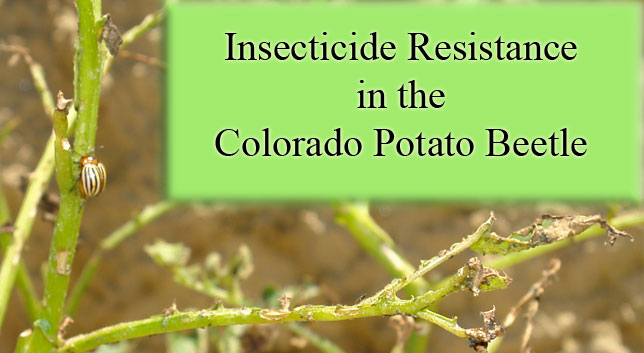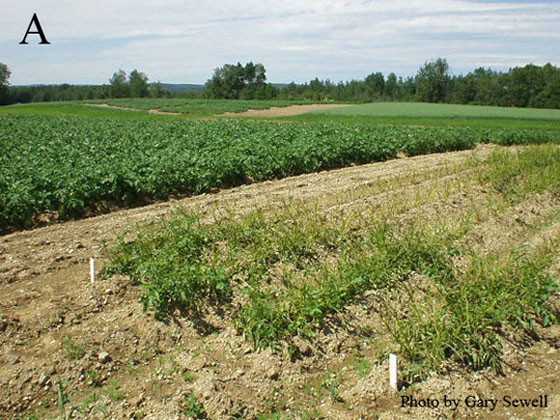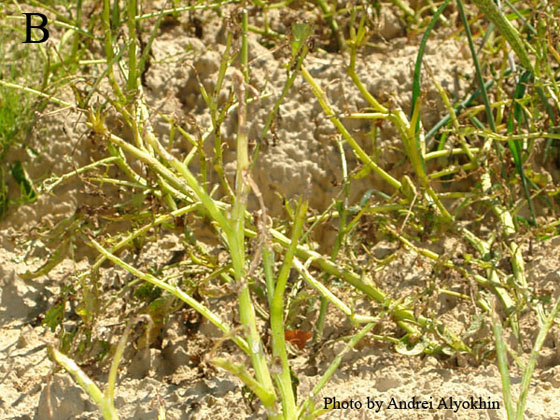

Description
Colorado potato beetle, Leptinotarsa decemlineata (Say), is a leaf beetle in the family Chrysomelidae. The adult is approximately 3/8 inch (10 mm) long, yellowish in color with dark orange head and ten black longitudinal stripes on its back (Fig. 1.1A). The eggs are yellowish-orange, usually found in clusters of 20-50 eggs on the undersides of leaves (Fig. 1.1B). The larva is between 1/8 to 1/2 inch (3 to 13 mm) long and slug-like in appearance. It is red in color with two rows of black spots along each side and black legs and head (Fig. 1.1C). The yellowish or pinkish pupa (not shown) lives in the soil and is not easily seen in the field.

Fig. 1.1. Colorado potato beetle life stages. A-adult; B-eggs; C-larva.
Damage
Colorado potato beetle is arguably the most important insect pest of potatoes. Both adults and larvae feed on potato foliage, and the absence of control measures often results in complete defoliation of potato fields (Fig. 1.2). None of the control techniques developed since this insect became a pest has provided long-term protection of potato crops, and the beetle continues to be a major threat to potato production. High fecundity, a diverse and flexible life history, and a remarkable ability to develop insecticide resistance make Colorado potato beetle management a challenging task.

 Fig. 1.2. Colorado potato beetle damage to potato plants. A-untreated potato plot adjusted to a potato field protected from the Colorado potato beetle damage by insecticide applications; B-close-up photograph of defoliated plants.
Fig. 1.2. Colorado potato beetle damage to potato plants. A-untreated potato plot adjusted to a potato field protected from the Colorado potato beetle damage by insecticide applications; B-close-up photograph of defoliated plants.
Life History
The Colorado potato beetle has a complicated and diverse life history (Fig. 1.3). The beetles
 Fig. 1.3. Schematic diagram of the Colorado potato beetle life history. Only one generation is shown, but two-three generations are possible in the areas with warmer climates. Please click on the picture for a bigger image.
Fig. 1.3. Schematic diagram of the Colorado potato beetle life history. Only one generation is shown, but two-three generations are possible in the areas with warmer climates. Please click on the picture for a bigger image.
overwinter in the soil as adults, with the majority aggregating in woody areas adjacent to fields where they have spent the previous summer. The emergence of post-diapause beetles is more or less synchronized with potatoes. If fields are not rotated, they are colonized by overwintered adults that walk to the field from their overwintering sites or emerge from the soil within the field. If fields are rotated, the beetles are able to fly up to several kilometers to find a new host habitat. Once they have colonized the field, the overwintered beetles first feed and then oviposit within 5-6 days depending on temperature. A single female is capable of producing ca. 600 eggs. Overwintered adults live for one-two months after colonizing host plants in the spring.
Eggs laid by the overwintered adults begin to hatch within one week from oviposition. Newly emerged larvae disperse over short distances and almost immediately start feeding on potato foliage. The larvae spend most of their time on plants. They undergo three molts, with the last (fourth) instars burrowing into the soil to pupate. Larval development usually takes 10-20 days, and pupal stage lasts for another 10-15 days. The first summer generation adults dig out of the soil and climb back on potato plants. It takes them about 7-9 days to develop a reproductive system and flight muscles. After development has been completed, the beetles mate and start laying eggs.
The reproduction continues until diapause is induced by decreasing day length in the autumn. Then the beetles migrate to overwintering sites (mainly by flying), and enter the soil to diapause. Those beetles that emerge under short-day photoperiod do not develop their reproductive system and flight muscles that season. They feed actively for several weeks and then either walk to the overwintering sites or burrow into the soil directly in the field.
Colorado potato beetle's diverse and flexible life history is well-suited to unstable agricultural environments, and makes it a complex and challenging pest to control. Flight migrations closely connected with diapause, feeding and reproduction allow the Colorado potato beetle to employ "bet-hedging" reproductive strategies, distributing its offspring in both space (within and between fields) and time (within and between years). Such strategies minimize the risk of catastrophic losses of offspring, otherwise quite possible in unstable agricultural ecosystems.
Distribution
Since Colorado potato beetle shifted from its original wild hosts in southwestern North America, it has spread throughout the rest of the continent and has invaded Europe and Asia. Currently its distribution covers about 8 million km2 in North America and about 6 million km2 in Europe and Asia. It has appeared recently in Central Asia, western China and Iran. Potentially the Colorado potato beetle can occupy much larger areas in China and Asia Minor, spread to Korea, Japan, Russian Siberia, certain areas of the Indian subcontinent, parts of North Africa, and the temperate Southern Hemisphere.
For an in-depth scientific review of insecticide resistance in the Colorado potato beetle, please refer to
Alyokhin, A., M. Baker, D. Mota-Sanchez, G. Dively, and E. Grafius. 2008. Colorado potato beetle resistance to insecticides. American Journal of Potato Research 85: 395–413.
Click here to read full text of the article free of charge.